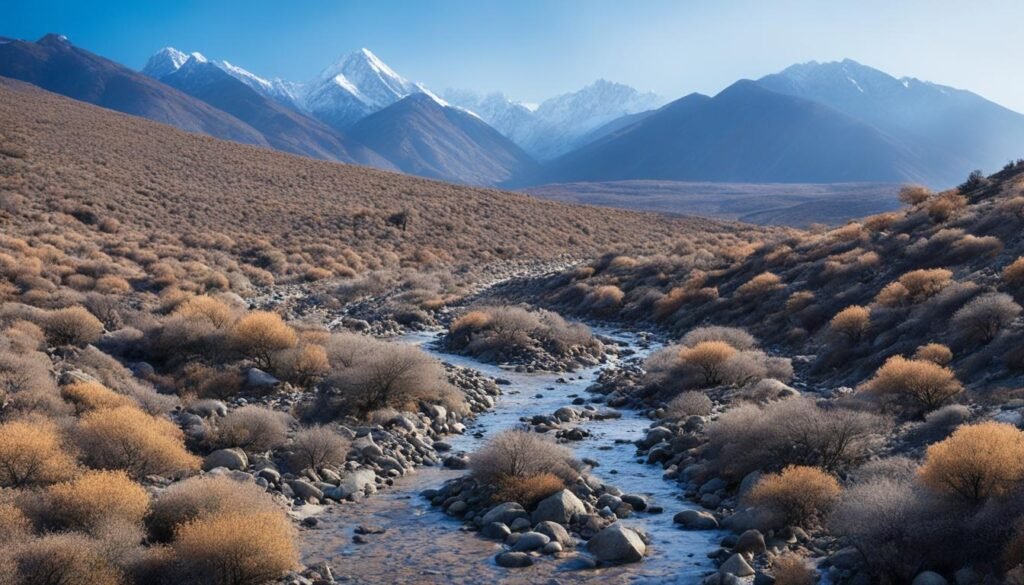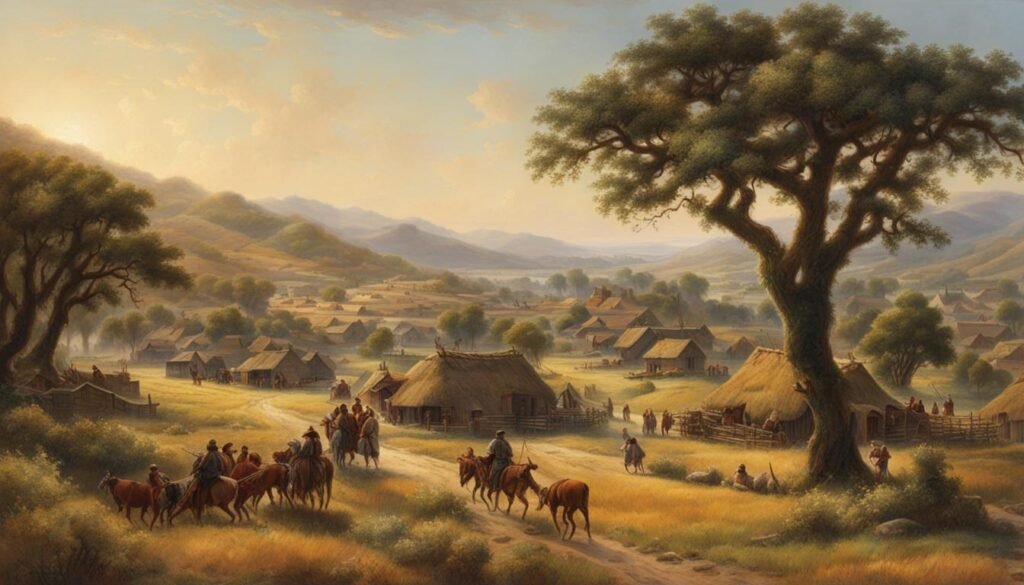Greetings! I’m excited to take you on a virtual journey through the incredible habitats of California. From the coastal ecosystems to the majestic redwood forests, this state is a haven for diverse plant and animal species. Join me as we delve into the natural wonders that make California such a captivating place.
Key Takeaways:
- California is home to a variety of habitats, from coastal areas to alpine tundras.
- These habitats support a rich diversity of plant and animal species.
- Conservation efforts are essential to protect and preserve California’s native habitats.
- The different habitats in California offer unique opportunities for exploring and appreciating nature.
- Understanding and appreciating these habitats helps us foster a deeper connection with the natural world.
Coastal Habitat: A Marine Wonderland
As I dive into the coastal habitats of California, I am mesmerized by the breathtaking fusion of land and sea. This unique ecosystem is home to a remarkable array of species, each perfectly adapted to thrive in this marine wonderland. From playful sea otters and serene harbor seals to graceful shorebirds, the coastal habitats of California teem with life.
One of the most vital components of this ecosystem is the intertidal zone, the area where the land and sea collide. This dynamic space experiences the constant ebb and flow of tides, creating a habitat like no other. It is a sanctuary for organisms such as anemones, crabs, and mussels. The intertidal zone serves as a nursery for juvenile fish, providing a safe haven for them to grow and develop. It also acts as a buffer zone, protecting the coast from erosion and providing essential resources for coastal communities.

California’s coastal ecosystems are not only visually stunning but also ecologically significant. They play a crucial role in supporting the overall health of our planet. Coastal habitats act as carbon sinks, absorbing and storing carbon dioxide, a greenhouse gas responsible for climate change. They provide a natural barrier against storms and hurricanes, shielding coastal communities from their destructive force. These habitats also contribute to the economy through tourism and recreational activities, attracting visitors from around the world.
However, like many habitats in California, coastal ecosystems face significant threats due to human activities. Pollution, habitat destruction, overfishing, and climate change pose severe challenges to the delicate balance of these habitats. Efforts are underway to combat these threats, with organizations and individuals working tirelessly to preserve and protect the coastal ecosystems of California. Through conservation initiatives and sustainable practices, we can ensure the longevity of these precious habitats and safeguard the incredible biodiversity they harbor.
- Sea otters
- Harbor seals
- Shorebirds
- Anemones
- Crabs
- Mussels
The coastal habitats of California are remarkable in their beauty and ecological significance. They serve as a testament to the wonders of nature and the importance of preserving our natural heritage. By valuing and protecting these diverse ecosystems, we can ensure a sustainable future for both the wildlife and coastal communities that call California home.
Redwood Forest: Giants of the Plant World
The redwood forests of California are truly remarkable. These majestic trees, known as the giants of the plant world, create an awe-inspiring habitat that is unlike any other. The coast redwoods (Sequoia sempervirens) and giant sequoias (Sequoiadendron giganteum) can reach staggering heights, with some soaring over 300 feet tall and living for thousands of years.
These ancient trees provide a sanctuary for a diverse array of plant and animal species. In the shade provided by the towering canopies, one can find the enchanting marbled murrelet, a seabird that nests high above the forest floor. The forest also teems with life on the ground, where banana slugs slowly make their way through the damp undergrowth, vital to the forest’s decomposition process.
The redwood forest is also home to the elusive northern spotted owl. With their excellent camouflage and silent flight, these owls are expert hunters in the dense forest. The conservation of these incredible giants is vital for the preservation of the redwood habitat and the delicate balance of its biodiversity.
Preserving the Redwood Forest
Preserving the redwood forests in California is of utmost importance to maintain the habitat and protect the native plants and animals that call it home. Efforts to conserve these ancient trees include acquiring and managing forestlands, establishing protected areas, and implementing sustainable logging practices.
Organizations such as the Save the Redwoods League and the Sierra Club have been instrumental in advocating for the preservation of these forests and raising public awareness about their significance. Through their ongoing efforts, vital habitats are protected, allowing future generations to enjoy the majestic beauty and unique biodiversity of California’s redwood forests.
Exploring the Redwood Forest
- Take a guided hike through one of California’s many redwood parks to experience the towering beauty of these ancient trees firsthand.
- Visit the Redwood National and State Parks, where you can explore the diverse ecosystem and witness the grandeur of the redwoods.
- Learn about the native plants and animals that thrive in the redwood forest and their important roles within the ecosystem.
Chaparral: California’s Mediterranean Shrubland
The chaparral habitat in California is a unique and fascinating ecosystem. Stretching across the state’s scrublands and grasslands, the chaparral resembles the landscapes found in the Mediterranean region. This habitat is characterized by its dense shrubbery and sun-baked earth, creating an environment that is both rugged and beautiful.
Within the chaparral, a diverse range of plant and animal species have adapted to thrive in the dry and harsh conditions. One iconic resident of the chaparral is the California quail, known for its distinctive plume and melodious call. The coast-horned lizard, with its spiky appearance and excellent camouflage skills, blends seamlessly into the landscape. And let’s not forget the majestic mountain lion, a top predator that roams these rugged hills.
The plants of the chaparral have also adapted to survive in this arid environment. They have developed features such as deep root systems and tough, leathery leaves that minimize water loss. Some examples include the manzanita, ceanothus, and chamise, all of which play important roles in the ecosystem.

The chaparral habitat is not only a beautiful landscape but also a critical ecosystem that supports a wide range of species. However, like many habitats in California, it faces challenges such as habitat loss and fragmentation. Efforts are being made to conserve and protect the chaparral through initiatives that promote habitat restoration and reduce the impact of human activities.
Preserving the chaparral and its biodiversity is essential for maintaining the balance of California’s ecosystems and ensuring the survival of its unique plant and animal species.
Alpine Tundra: Life at High Elevations
California’s alpine tundra is a challenging and awe-inspiring environment located at high elevations. This unique habitat is characterized by rocky terrain, freezing temperatures, and limited vegetation. Only the most resilient plants and animals can survive in this harsh and extreme landscape.
One of the iconic species that call the alpine tundra home is the pika. These small, herbivorous mammals have evolved to withstand the cold temperatures by hibernating during the winter and gathering food during the brief summer months. Their dense fur provides insulation, allowing them to navigate the rocky slopes and scree fields without difficulty.
Another fascinating species found in California’s alpine tundra is Belding’s ground squirrel. These ground-dwelling rodents have adapted to survive in the high-elevation environment by hibernating for an extended period of time. They emerge from their burrows in the summer to mate, forage, and store food for the winter months.
The alpine butterfly is yet another extraordinary inhabitant of this challenging habitat. With its vibrant colors and delicate wings, this butterfly has developed unique survival strategies. It has a rapid life cycle, completing its entire life cycle within a few weeks during the brief alpine summer.
Challenges and Conservation Efforts
Despite the harsh conditions, California’s alpine tundra is a fragile ecosystem that requires protection and conservation. Climate change poses a significant threat to these high-elevation habitats, with rising temperatures affecting the availability of suitable habitats for alpine species.
Efforts are being made to conserve and protect the alpine tundra habitats in California. These include monitoring and research programs to better understand the impacts of climate change, implementing measures to reduce human disturbances in sensitive areas, and raising awareness about the importance of preserving these unique habitats.
The image above depicts the breathtaking beauty of California’s alpine tundra, showcasing the rocky landscape, snow-capped peaks, and resilient vegetation. This visual representation serves as a reminder of the incredible diversity and natural wonders present in California’s high-elevation habitats.
In conclusion, California’s alpine tundra is a challenging yet captivating habitat that is home to a variety of unique species. Its harsh conditions and high elevations require specialized adaptations for survival. Conservation efforts are essential to preserve these fragile ecosystems and ensure the long-term survival of the plants and animals that call the alpine tundra their home.
Desert Oasis: Resilience in the Arid Landscape
When you think of a desert, you may envision a barren wasteland devoid of life. But California’s desert habitats tell a different story. Hidden within this seemingly harsh and arid landscape are thriving oases, home to a remarkable array of plant and animal species.
One iconic resident of these desert oases is the Joshua tree. With its twisted branches and spiky leaves, this unique tree stands as a symbol of resilience. It has adapted to survive in the arid conditions, relying on its deep root system to access the limited water supply. Despite the harsh desert environment, the Joshua tree perseveres, providing shelter and sustenance for a variety of desert-dwelling creatures.
Another desert oasis resident is the desert tortoise. This ancient reptile has developed remarkable adaptations to thrive in the extreme heat and scarcity of water in the California desert. Its ability to store water in its bladder and withstand long periods without drinking make it well-suited to the arid habitat. The desert tortoise plays a vital role in maintaining the delicate balance of the desert ecosystem.
The desert oasis is also a haven for the kit fox, a small and elusive predator. This swift creature has adapted to the scorching heat by hunting and scavenging during the cooler nighttime hours. Its ability to survive in such a challenging environment exemplifies the incredible resilience of California’s desert habitats.
FAQ
What are some of the different habitats found in California?
California is home to a variety of habitats, including coastal ecosystems, redwood forests, chaparral, alpine tundra, and desert oases.
What kind of wildlife can be found in California’s coastal habitat?
California’s coastal habitat is home to species such as sea otters, harbor seals, and a variety of shorebirds.
What is unique about the redwood forest habitat in California?
The redwood forests in California are known for their towering trees and are home to a wide range of species, including the marbled murrelet, banana slug, and northern spotted owl.
What type of habitat is the chaparral in California?
The chaparral in California is a Mediterranean shrubland characterized by dense shrubbery and sun-baked earth. It is home to species such as the California quail, coast-horned lizard, and mountain lion.
What kind of plants and animals can survive in California’s alpine tundra?
California’s alpine tundra is a challenging habitat for life, but species such as the pika, Belding’s ground squirrel, and alpine butterfly have unique adaptations that allow them to thrive in this extreme environment.
What is unique about California’s desert oasis habitat?
California’s desert oasis may appear barren, but it is home to iconic species such as the Joshua tree, desert tortoise, and kit fox, which have adapted to survive in this harsh and arid landscape.







